We anchored in Cascais on Sunday (September 14) and got welcomed with winds up to 15 m/s. This is only as far as we happened to be looking at the wind instrument…
We laid 40 m of chain in the 7 m depth (depth at high tide), we set up 2 anchor alarms and cancelled our plan to go onshore to get a beer in a bar. It would have been just impossible to relax and enjoy, knowing that Lovisa is hanging on her anchor with some risks to drag in such strong winds. The good thing we noticed afterwards the next morning is that she actually didn’t drag a cm!
First thing in the morning we started our preparation works for the crossing to Madeira. On the way along the coast of Portugal we had dressed a list of all the checks we wanted to do prior to do the crossing and some small equipment we wanted to buy.
Here is short summary of what we have done.
Check anodes
The picture below shows the two anodes that we mounted on the propeller shaft before launching the boat in April. The anode at the end of the shaft disappeared, but that was not a surprise. We still don’t really understand how that model of anodes should be fitted to the shaft. They are supposed to be simply screwed to the shaft but if we use Loctite to lock them, we risk to lose galvanic connection and therefore there would be no meaning to have an anode. If we don’t use Loctite, it would eventually get loose after some time running on engine and then detach, ending up on the bottom of the sea. When we checked it in Camaret-Sur-Mer, the anode was still there although it was loose and we had to retighten it under water. Now that it detached, we decided not to mount a new one and rely only on the anode that is mounted between the propeller and the propeller shaft bearing.
The best solution would have been to use another design of anode but that would require a replacement of the nut that holds the propeller with one that is designed to allow the mounting and securing of an anode.
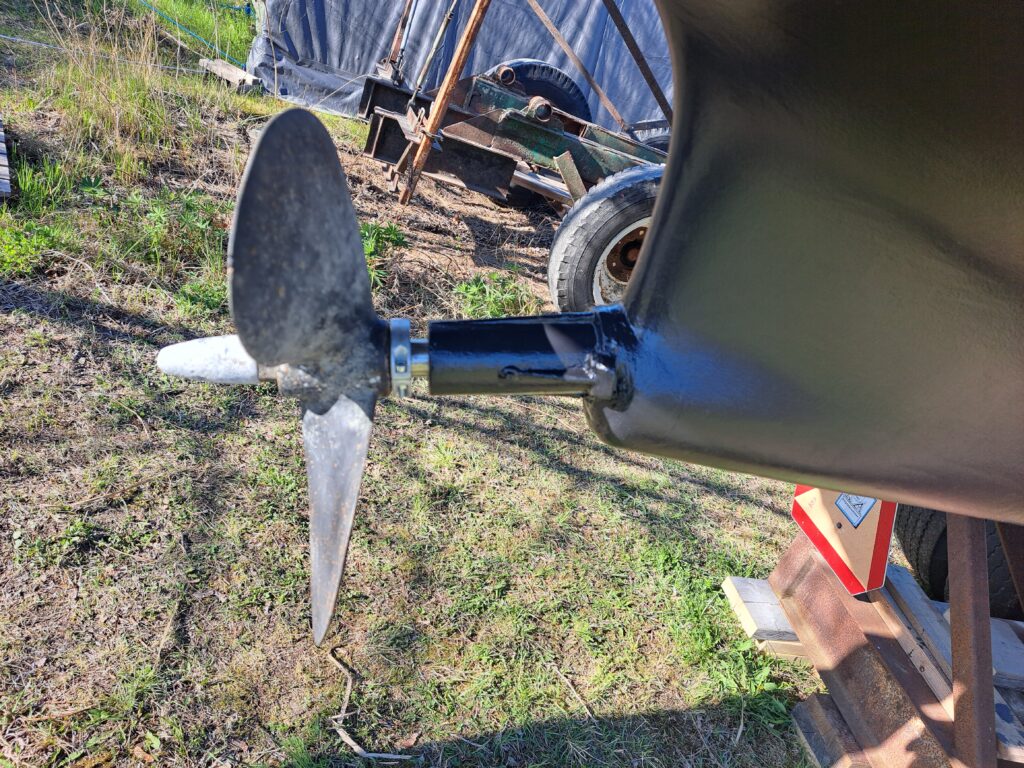
The anode between the propeller shaft bearing and the propeller was still in place and was corroding at normal pace.
The anode on the bow thruster was also still in place and corroding at normal pace. We decided not to mount a new one for now.
Check forward sonar
The forward sonar is not covered with antifouling paint. In Sweden we usually find small shells stuck on it at the end of the sailing season. After 4 months in the water we were getting ready to make some cleaning but to our surprise, there was nothing on it. Same thing for the logger. We don’t know why, but this makes us happy!
Replace the mainsail sliders
During previous weeks sailing along the coast of Portugal, we broke two main sail sliders in normal sailing conditions. We supposed that the plastic had become weaker due to long exposition to UV. Although it is very well possible to replace these at sea, from some previous experience we know that when one start to break just like that, the others will follow so we replaced all the remaining ones with the spares that we already had onboard.
Repair of exhaust gas silencer
During our routine checks when we were in Germany we noted some corrosion on the stainless steel pipe that is welded to the actual exhaust gas silencer. Since then, we kept looking at it regularly to follow the progression. As the corrosion has worsen quite a bit, we decided to remove it in order to have it repaired in some local workshop. They did a simple repair, grinding off the corroded areas and rewelding over it. We’ll see how far it holds.
We took the opportunity of having the silencer removed to also replace the exhaust gas hose that connects the engine to the silencer. We wanted to replace as well the long one from the silencer to the through hull but no shop had the size we needed on the shelf.
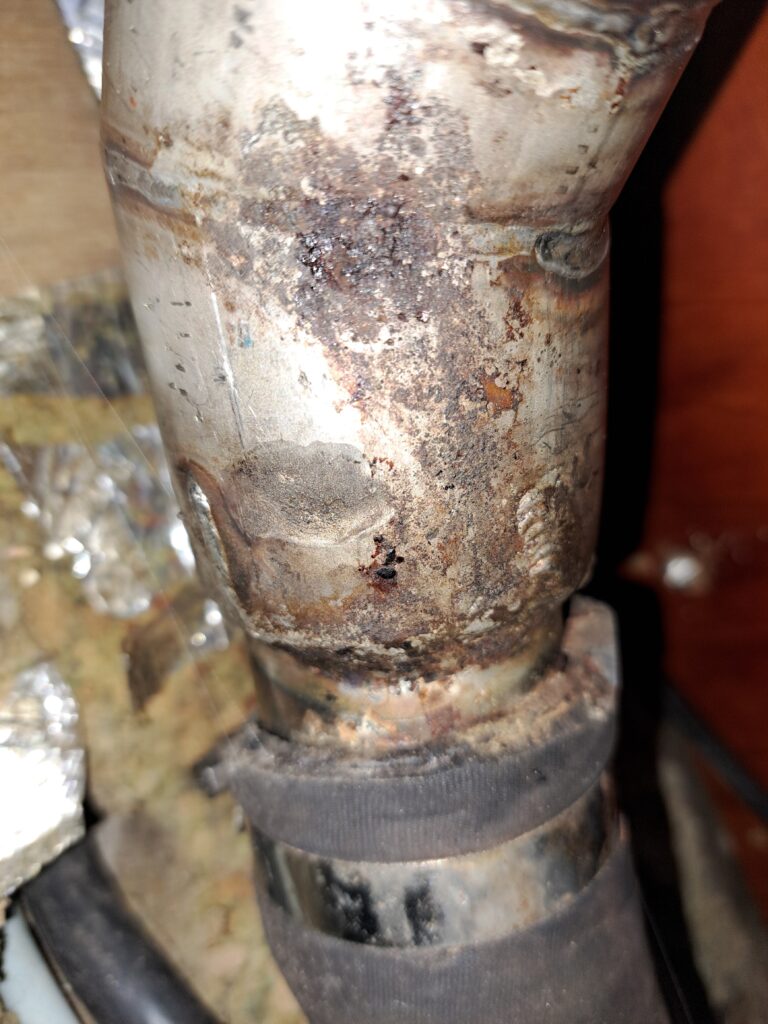
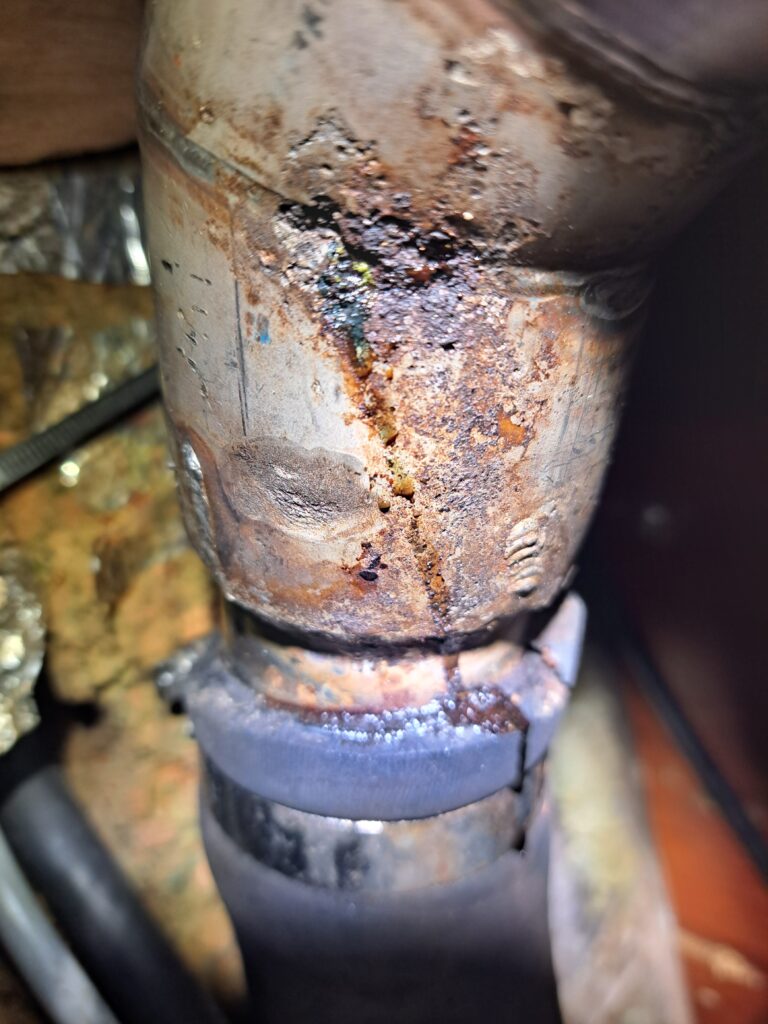
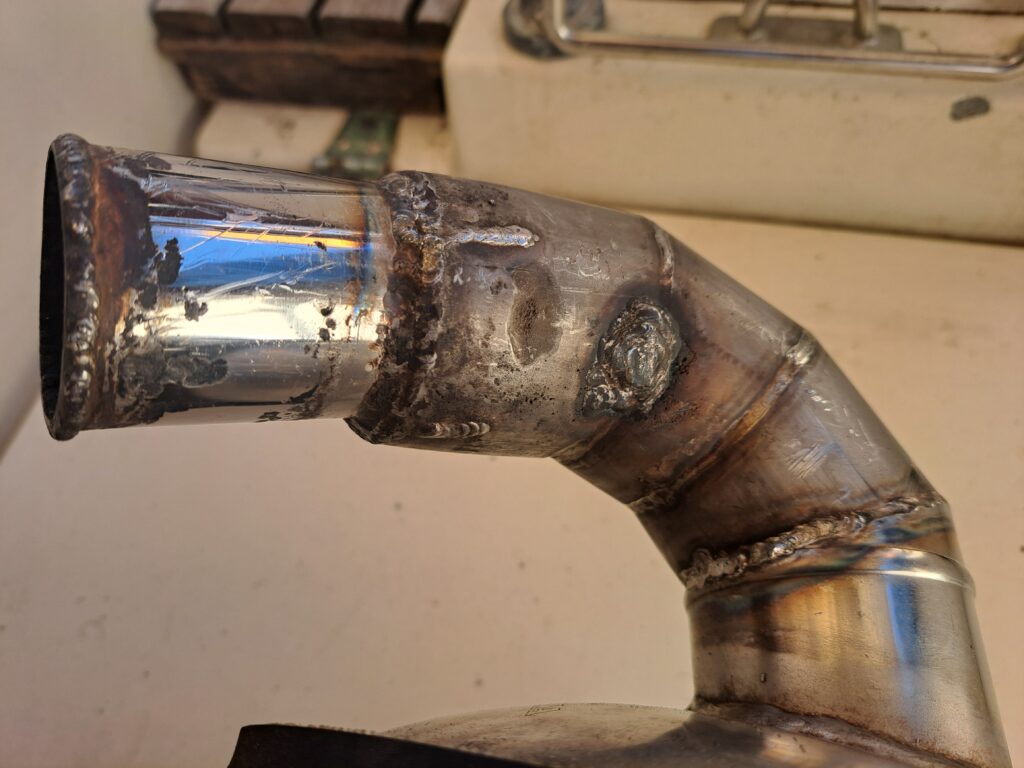
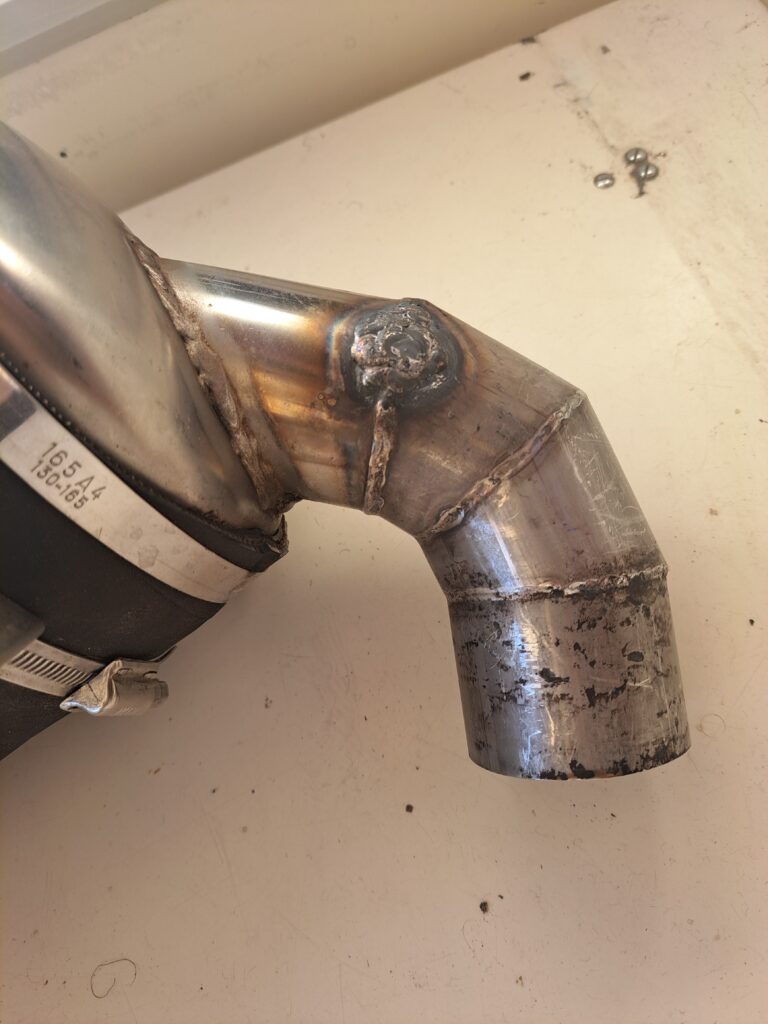
Replacement of impeller of engine raw water pump
The engine had been running a lot since we left Sweden. Prior to the long crossings that was awaiting us we wanted to have fresh impeller in the raw water pump. The impeller that we removed was a little bit damaged (two blades cracked) but nothing very severe, we have seen worse at the end of a sailing season like impeller running with only half of the blades still in place, and still pumping water.
With a fresh impeller mounted we would feel confident to run the engine even for several days during the coming crossings.
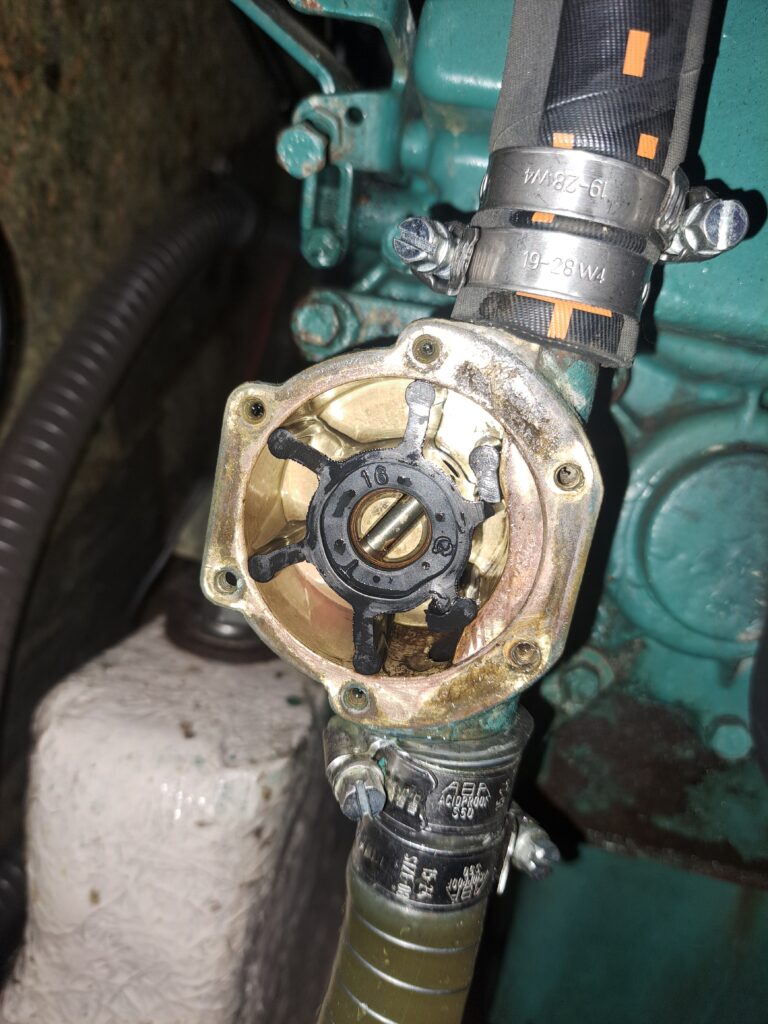
Replacement of windvane bushings
The windvane was working fine but the mechanism had a lot of play between several of the moving components of the mechanism. We tried to reduce a bit of that play by replacing the worn out bushings of the actuator.
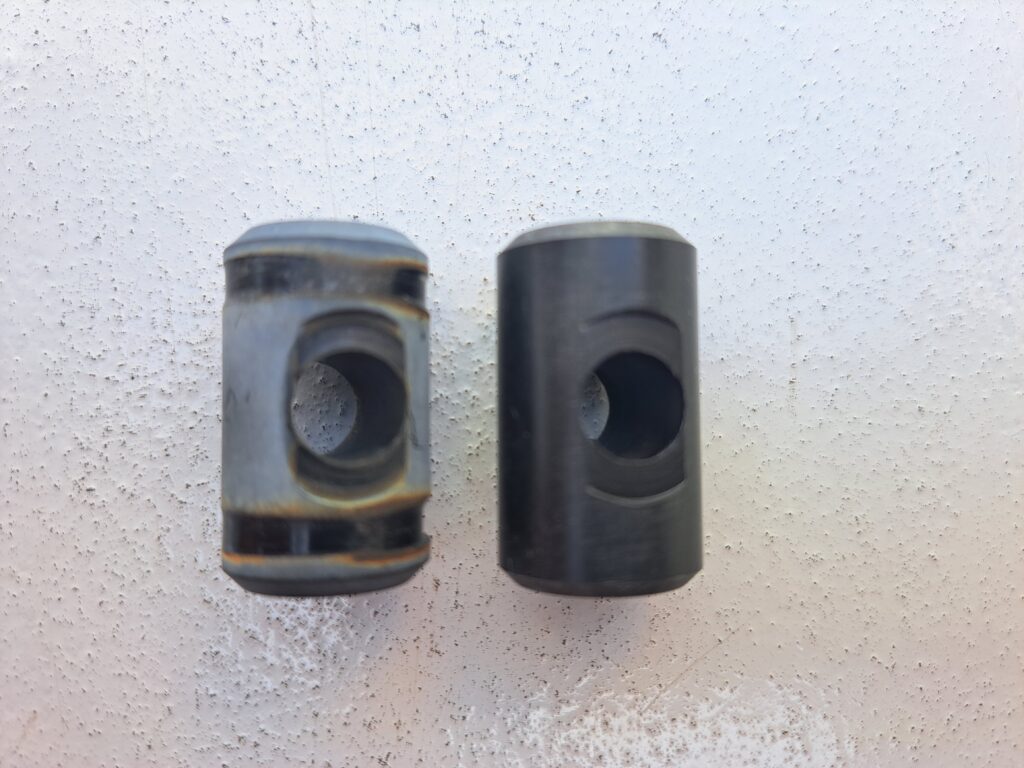
Generic checks prior to departrure
As we had been doing prior to leaving from nearly every harbor, we went through our check list for the engine: we checked the oil level, we checked that the raw water filter was free from algae, we verified that the level of cooling fluid was ok, we checked that the tension of the generator belt was good. We verified that we had no water in the diesel water separator.
We also cleaned the bilge, checked the state of the steering cable that connects the steering wheel to the rudder, and repaired a small damage that we found on the lazybag.
As we were expecting the crossing to Madeira to be mostly downwind, we prepared our boom preventer lines to be ready for use and prepared our EasyGybe boom breaker. Gybing in hard winds can be very dangerous as the boom crosses the cockpit from one side of the boat to the other very fast with risk to take it in the head. For our safety, when sailing downwind in hard wind conditions we use a boom breaker, a device that retains the boom but only partially so it passes the cockpit slower. It already helped us a couple of times, like in Biscay when we made an unwanted gybe when surfing on a wave. Using a breaker also helps prevent damages to the rigg.
Prior to leaving Marina de Cascais, we refilled the water tank. We also filled a 20 L jerry can with potable water … just in case … we never know.
We topped up the boat diesel tank adding 40 L of diesel. For this crossing we decided to keep with us additional 80 L reserve diesel. This means 210 L of diesel that correspond to 105 hours on engine at 1800 rpm (very roughly 5 knots).
With all this done we felt ready for Madeira!
We found also the time to complete another sewing project that were pending; a protection for UV when we are in harbors.
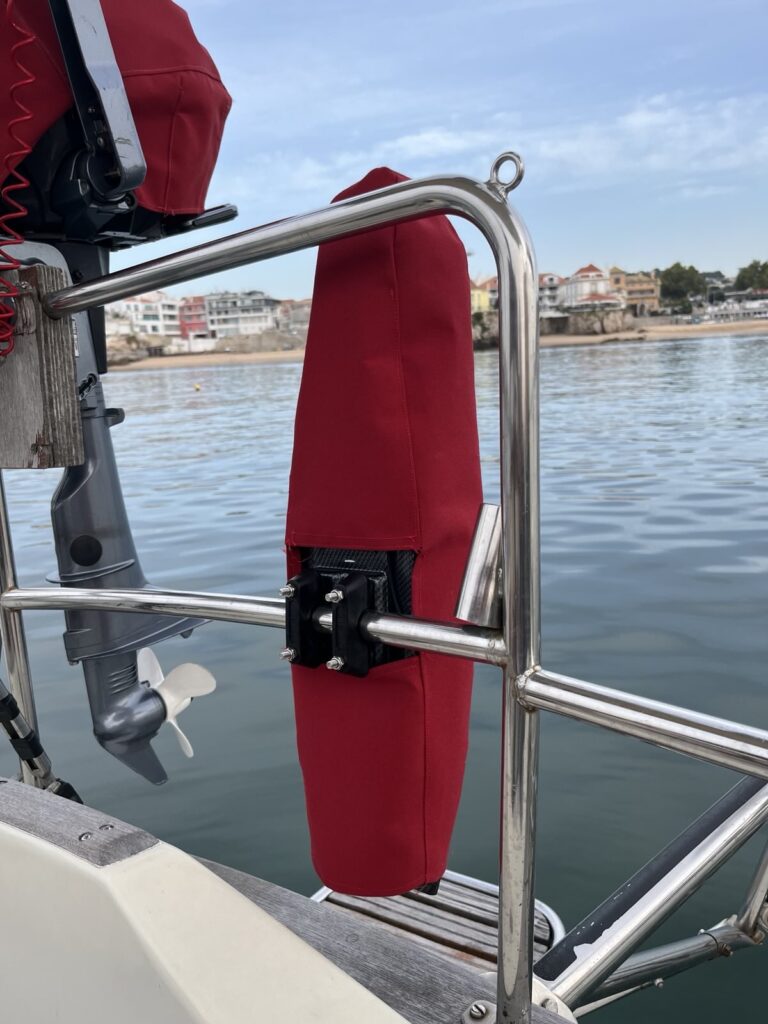
All these works left us very little time to actually visit either Cascais or Lisbon. We took the train to Lisbon for the usual purpose: finding as many boat stores as we could in a given time. But that small tour of the city was still very enjoyable.
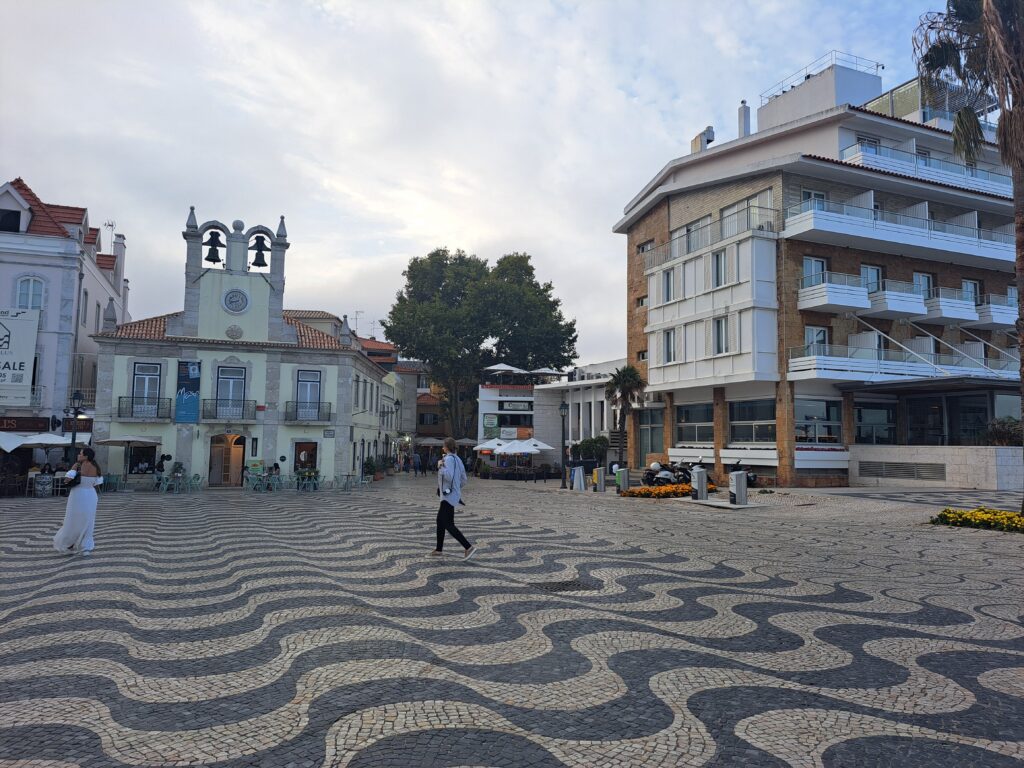
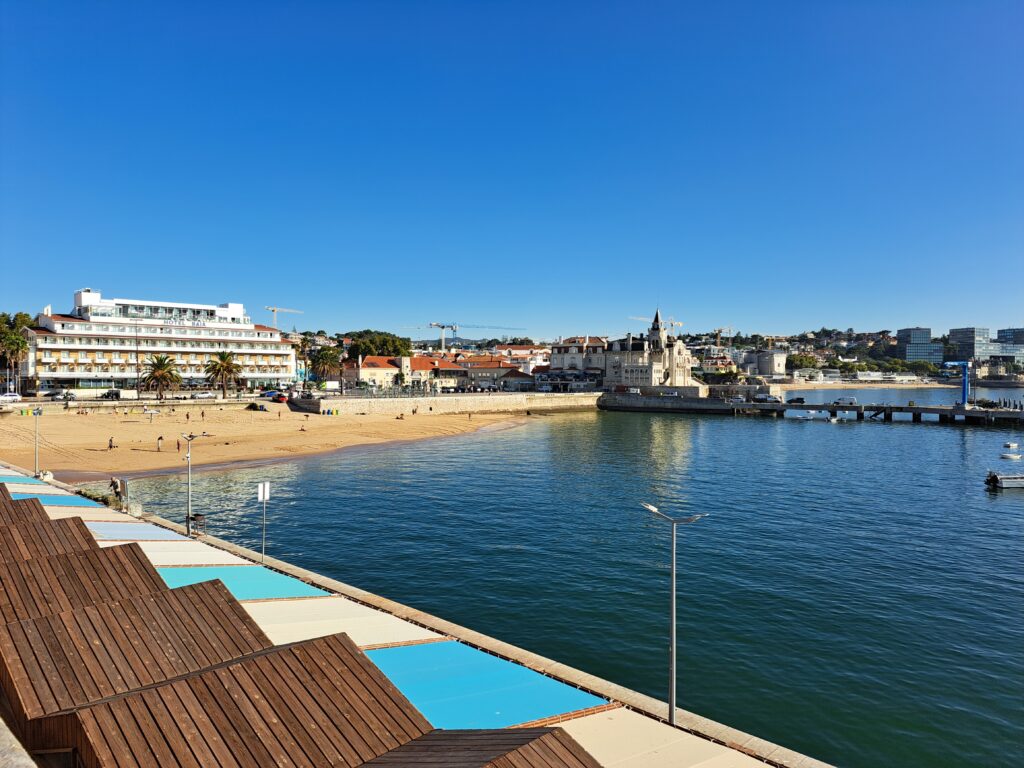
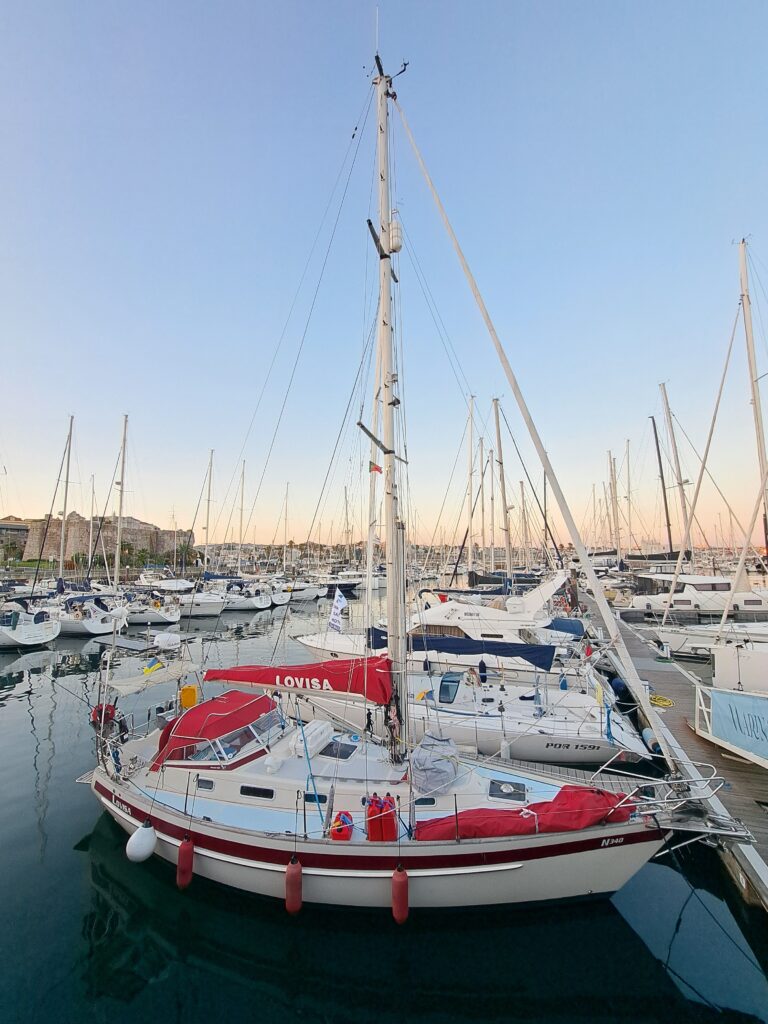
Day 1 (September 20)
After we crossed Bay of Biscay in August, we had been doing only coastal sailing. It was time for us to leave the comfort of coastal sailing and get back to the deep blue waters. At 11.20 we started the engine and lifted the anchor. We got to know that other boats were also planning to leave Cascais towards Madeira. It felt comfortable to know we would not be completely alone out there. We set sail a few nautical miles west of the harbor in 8-9 m/s wind as promised by the forecast. We started with both full mainsail and full Genoa. The wind increased rapidly to 13-14 m/s so we decided to drop the mainsail and continue with Genoa only. To wish us good luck we got surrounded by a huge pod of dolphins. Simply dolphins everywhere. Some playing in front of the boat, some swimming alongside, groups on port side, on starboard, adult and young ones. One in particular was jumping again and again along the boat like saying “Look what I can do!”. After some time it was just us. They left as fast as they came. Cascais and Lisbon slowly disappeared behind us as we set our course straight towards Porto Santo, bearing 225°. The trip started with high boat speed but also a lot of rolling that made the both of us feel a bit seasick and we felt so for the first couple of days.
For the 12 hours night sailing we did two three hour shifts each in similar wind conditions as we had during the day.
Day 2 (September 21)
Day 2 started with a wonderful sunrise and Lovisa just gliding (and unfortunately for us also rolling). During the afternoon and after several hours in operation, we decided to give a pause to the autopilot that had been working since middle of Day 1. We prepared and put the windvane in operation instead. It was the first time for us to try the windvane downwind. For some reason we were worried that the windvane would not steer precisely enough to avoid leading the boat to an unwanted gybe. But to our delightful surprise, the windvane steered the boat very well even in the waves and in the gusts of wind!
We ended Day 2 at high speed with a fantastic sunset!
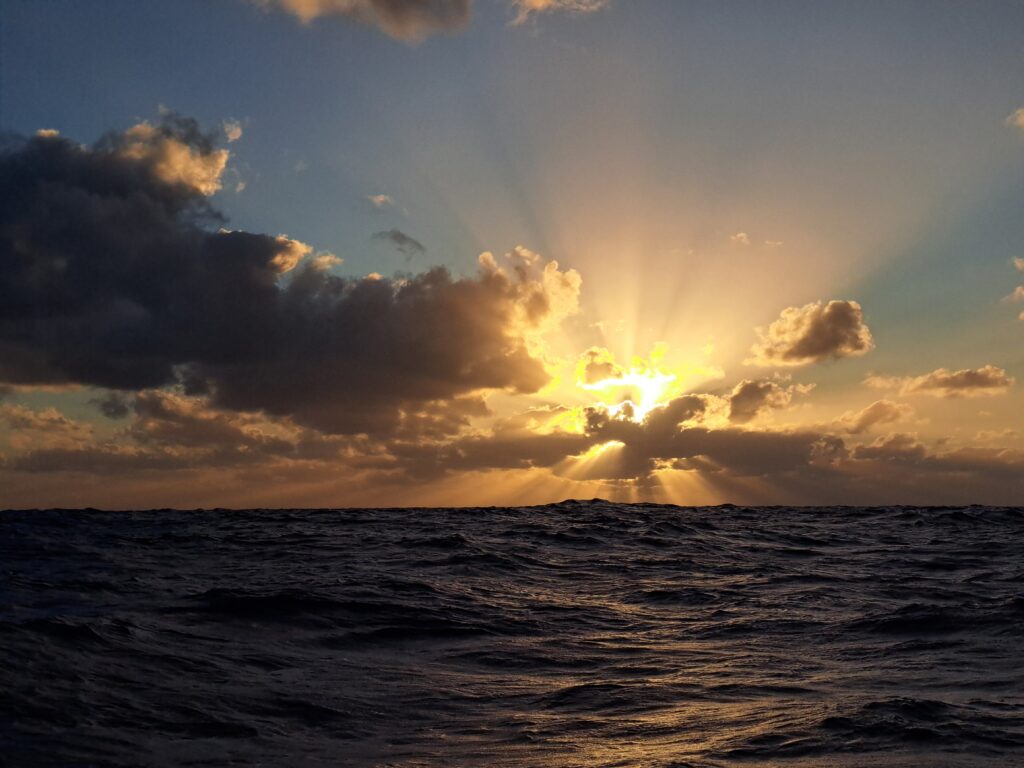
Day 3 (September 22)
Day 3 started like Day 2 with another beautiful sunrise and strong winds but these started to decrease with the hours passing by, leaving us at some point with only very little wind. But the waves were still there. We spent the entire day to follow the wind changes, changing sail combinations to try to make our day looking better that just a day rolling around. During Day 1 and Day 2, we managed to keep an average speed of 6.2 knots that is very good for Lovisa. Day 3 destroyed that performance. At around 23:00, with winds decreased as much as to 3.5 m/s so we decided to start the engine to continue make some miles and reduce the rolling. We ran on engine for about one and a half hours until the wind picked up again from 3.5 m/s to 11-12 m/s, allowing us to stop the engine and get back to what we came here for, that is to say sailing! The time on engine was actually a good opportunity to recharge the batteries of the boat a bit. They had decreased from the 98% we had when we left Cascais to 92%.
The idea to continue on engine until Madeira was horrible so the return of the winds saved a day that had been quite frustrating with all the wind shifts and worked to make Lovisa move forward.
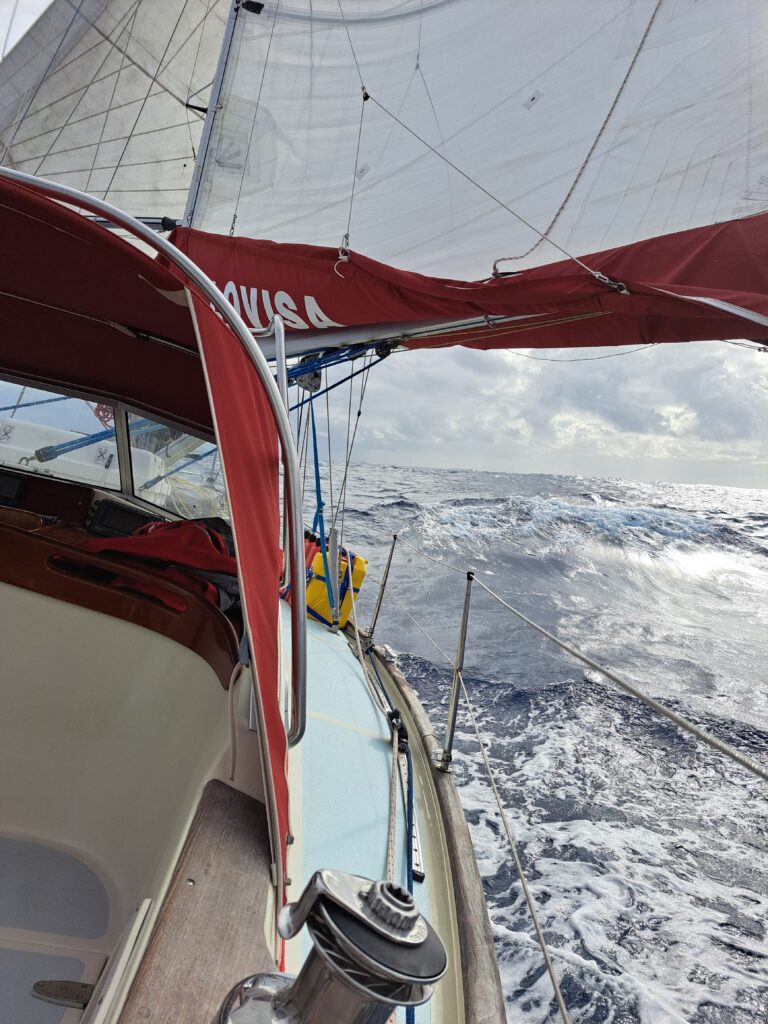
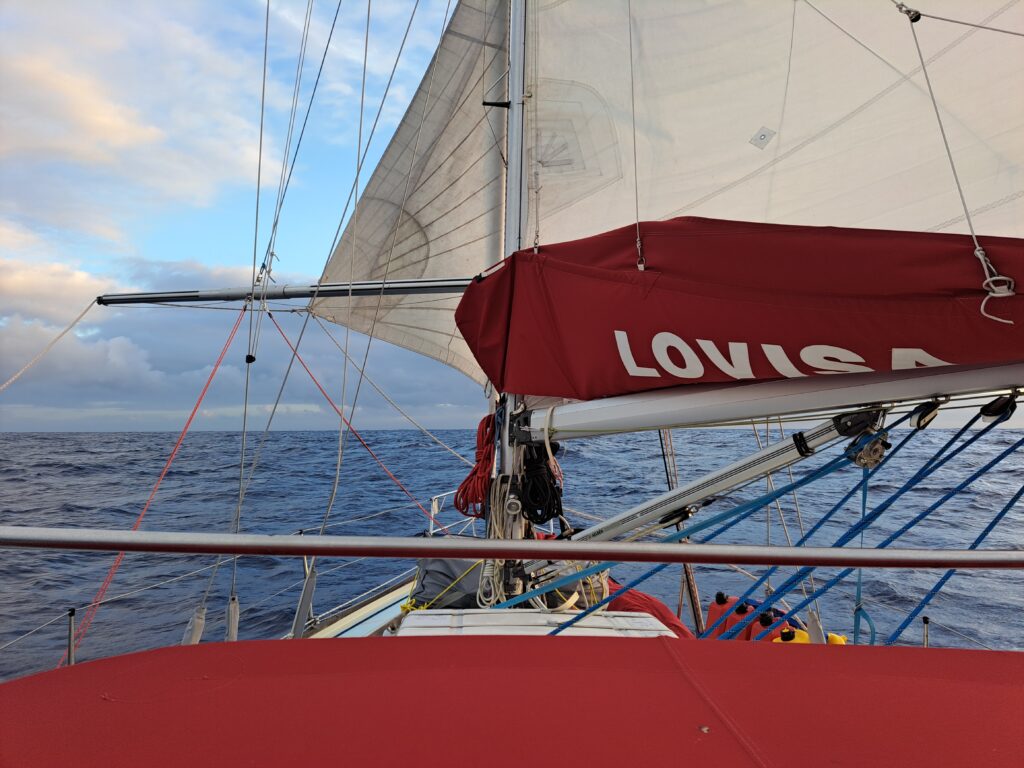
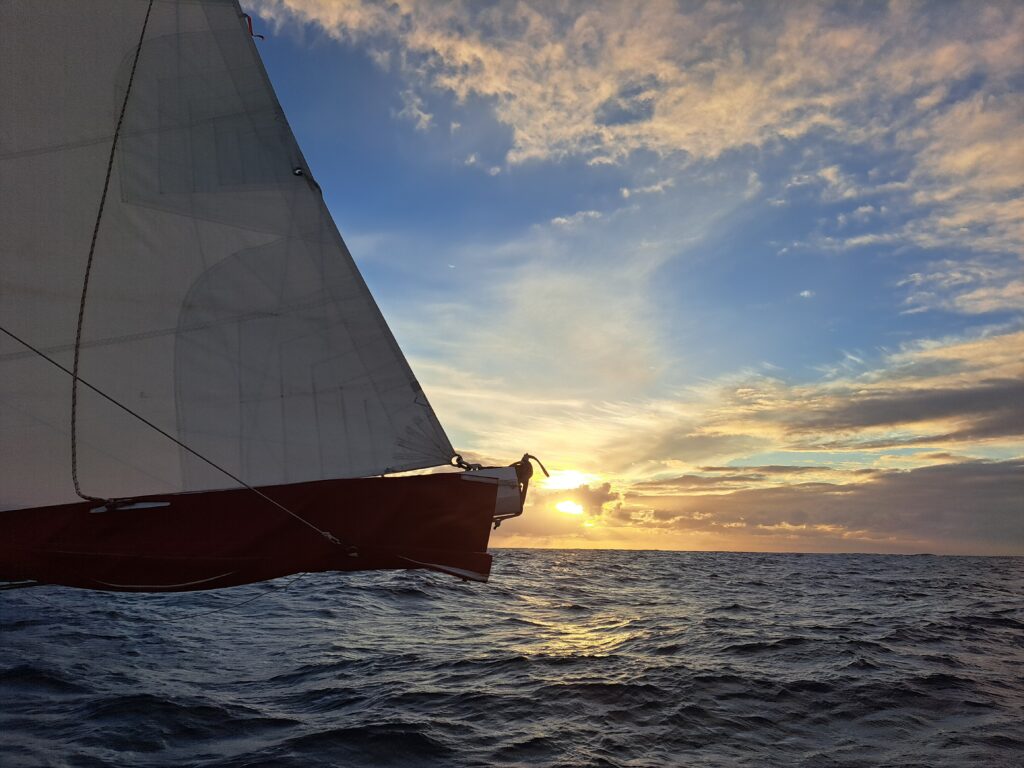
Day 4 (September 23)
The winds remained with us the entire Day 4 until we reached Madeira. We encountered low periods with winds around 6-7 m/s and periods more intense with 10-11 m/s. We left the windvane steer the whole way until we had Madeira in sight, at which time when we went back to the autopilot.
Day 4 marked a new turn in our sailing trip. We caught our first fish! A “Mahi-mahi” in French or English or a “Guldmakrill” in Swedish or “Pesce capone” in Italian. The question that arose as soon as we got the fish onboard was … “is it actually eatable”? At that point we had no idea what fish it was. It looked good but we didn’t want to take the risk of eating something we shouldn’t. Therefore we took a picture, cleaned the fish well and stored it in the fridge until we would get internet connection to confirm what it was.
The second high of that day happened late afternoon when we were mounting the spinnaker pole to keep the genoa in place. We were still 40 nautical miles away from Porto Santo and we were not expecting at all to see land from that far away. Actually we had no idea about how Porto Santo was looking like. No idea if it was a flat island or not. But while we were working we noted something at the horizon! Land! Our destination was just ahead of us even if it was still 8 hours of sailing to go including night sailing. And this is how we discovered that Porto Santo is a volcanic island.
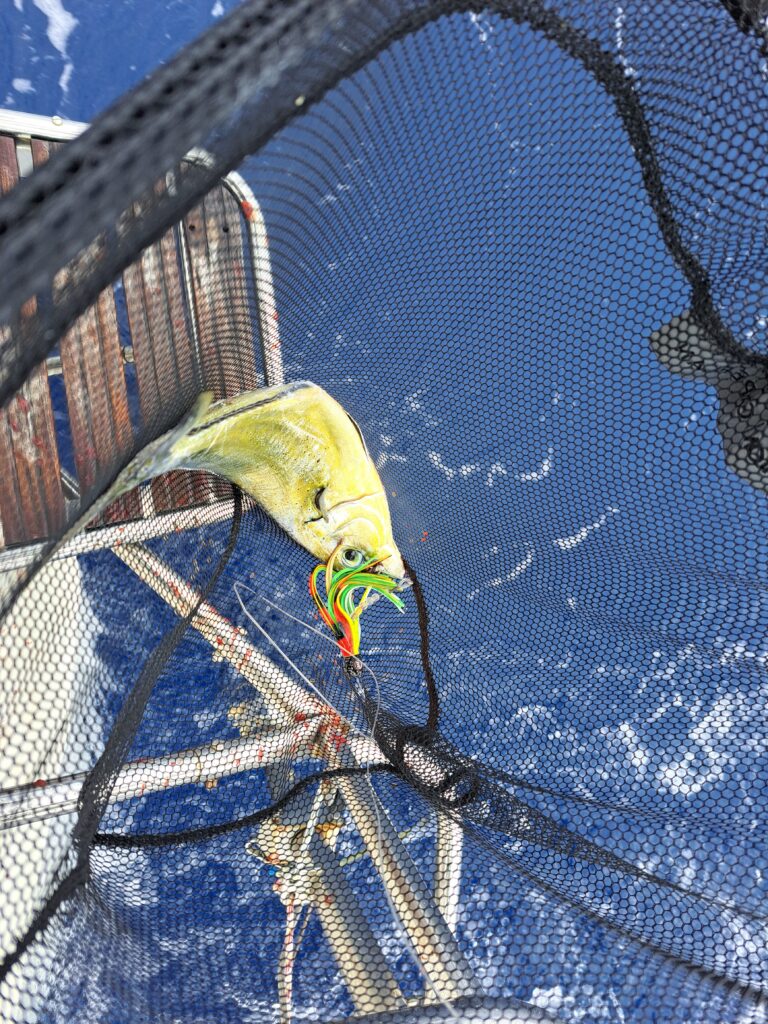
We finally anchored in Porto Santo on Wednesday (September 24) at around 03:00 in the morning after 480 nautical mile. There we found turquoise water. Through the 9 m depth we could clearly see the bottom. And finally the squeaking noises stopped.
Our first fish finally ended up on the menu for our first lunch on anchor in front of the beach of Porto Santo. We cooked it in a simple sauce with cherry tomatoes, olives and onions with potatoes and salad. Delicious!
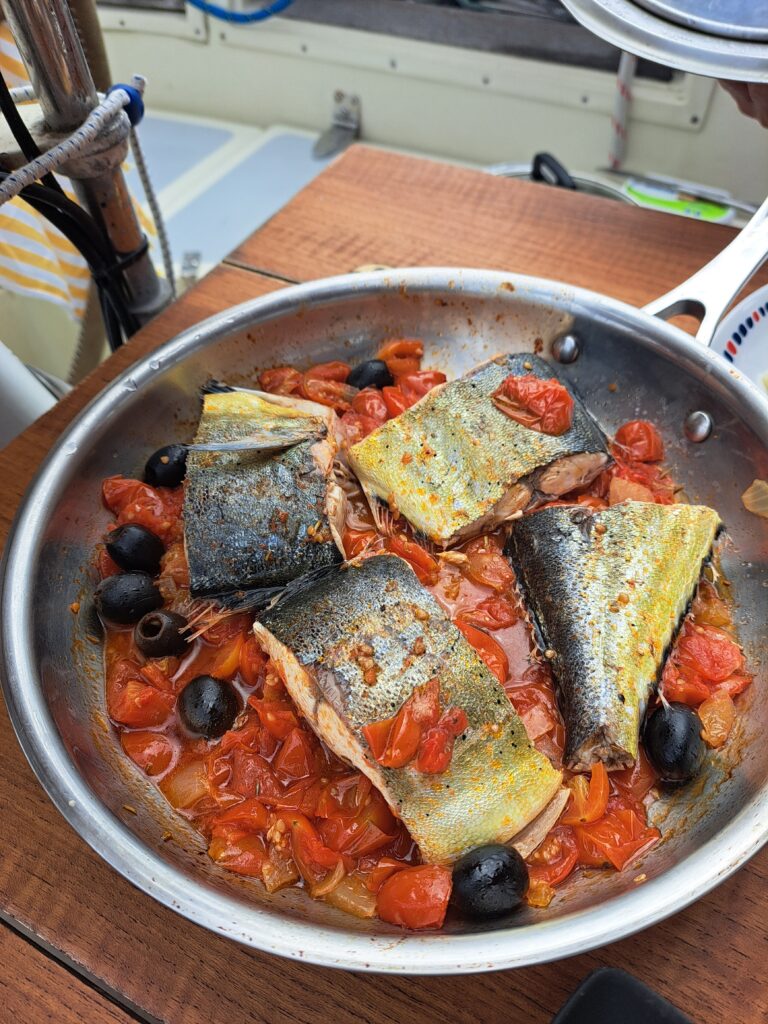
Personal thoughts Emilien
The crossing from Cascais to Madeira was a complete different experience compared with Bay of Biscay. During the first two days of the crossing we had a fantastic sailing with great speed over 6 knots average but life onboard was very uncomfortable with the boat rolling. It was hard to move in the boat, hard to cook, hard to go in the toilet, hard to read something without getting seasick during the first two days. The interior of the boat is made of woods and when the boat is rolling, the woods make a lot of squeaking noises that also makes it very hard for me to sleep (until at some point I am just too tired). During the first day I was a bit asking myself why I had chosen to be there, without really willing to be somewhere else. I was reflecting over that question while I was sitting in the cockpit during my night shift and I eventually found an answer right above my head, looking at the sky illuminated by million stars, a spectacle you can see only far away from any source of light, like on a boat in the middle of the sea. I found an answer at the back of the boat looking at the plancton by night that illuminate the water behind the boat. I found an answer when I finally saw Madeira, far away in the horizon after struggling with the wind, the waves, the lack of sleep with only water all around for some days.
Sailing long distance is not always fun. Sitting in an office 8-17 is not always fun either. But I feel that it is the intensity of the emotions that make all the struggles worth it.
Personal thoughts from Maria’s diary
Sunday September 21st, 11:30 (24 hours after leaving Cascais): Who sends the winds? I spend some time with Eva Dahlgren (Swedish musician, she wrote a song about this question) here in the changes between sun and clouds. Sometimes I see ships in the far distance and this also makes some company. Emilien is resting, there wasn’t much sleep last night in the waves. But the waves and wind push us towards Madeira. The water is incredibly blue. How did I end up here in the middle of a blue ocean in a boat? Because I wanted it, because I fought for it, because I was lucky … because someone sends the winds. With 10-13 m/s downwind we make over 6 knots by genua alone. It is relaxing not to have to worry about unintentional gybes with the main sail. We don’t even need to pole the genua in winds this strong. But right now we only have 7 m/s, I hope it will increase again soon. Emilien downloaded an updated weather forecast recently and it shows good winds until Monday evening, or if it was Tuesday evening. With good winds we should be there Tuesday evening. Perhaps it is strange that we want to get there as soon as possible? We are long distance sailors after all. But even if it is a unique experience with life’s simplicity in some sense on the boat (just get the boat running, eat and sleep), it is very uncomfortable as well. Every step should be planned to avoid loosing balance. Toilet visits require one arm in each direction for support. I am not rocked to sleep, I am shaken when I try to sleep. So…it is a good experience, but the best is to arrive, and then also knowing that we got there sailing our own boat. How many beautiful places we have seen! People usually take holidays for a week in Porto or any other of these places we have visited, seen, experienced and moved on. Is it our nomad souls that make us prefer this? Both of us have moved around in the world a lot after all. But still, the thoughts of home are there with me sometimes. Home is Östergötland, the forests and agricultural landscapes mixed. The people and all the everyday tasks. So, not 100 % nomad, but still enough for an adventure!
Tuesday September 23rd 15:40. Here I am again, contemplating the waves. Yesterday, I did not write, it was a terrible day and the word that came to mind was torture. The wind decreased and the sails were not stable in the waves that were still there. Not at all good for the sails. We tried everything, genua alone, main sail alone, both sails with genua in the same or opposite direction as the main, with or without poling the genua. A solution could work for some time but then winds changed. In the end, during my first night watch we took down the sails and went by motor. I was afraid not even that would work, because before when we used the motor to hoist or douce the mainsail, it sounded strange because the boat was heeling and rocking. But now it was fine. Later, the wind increased again and Emilien started sailing again during his watch. Today is a whole other day! All remains of sea sickness is gone for both of us. The wind has been good almost the whole time, and we have been able to relax and just be. It is so lovely to sit down and watch the waves. It feels like something is peeled off the soul, and all that remains is simplicity.
Wednesday September 24th, 18:30. Porto Santo. We got here by 3 AM. We had already seen the island 40 NM before! It was a happy shock, just when we had made a failed attempt at setting the genua pole without first rolling in the genua. Emilien pointed and I couldn’t believe my eyes! A lighthouse showed the way in the night later on, and we anchored with good distance to other boats since it was hard to tell the distance in the dark. It was great to have arrived, even if it was not as much of a relief as it was after the Bay of Biscay where we had to steer by hand the last day. Here instead, we had a great last day. But the sounds were annoying, with the squeeking of the wood interior. Silence is wonderful. Today, we put the dinghy in the water and looked at the sand bottom 9 m down under the turkoise water. We got a lovely cup of coffee and chat with the owners of S/Y L’aventure 3 which we now met for the first time on the trip (they are also in the ocean sailing club). After a shower, everything felt so nice. It is completely amazing here!
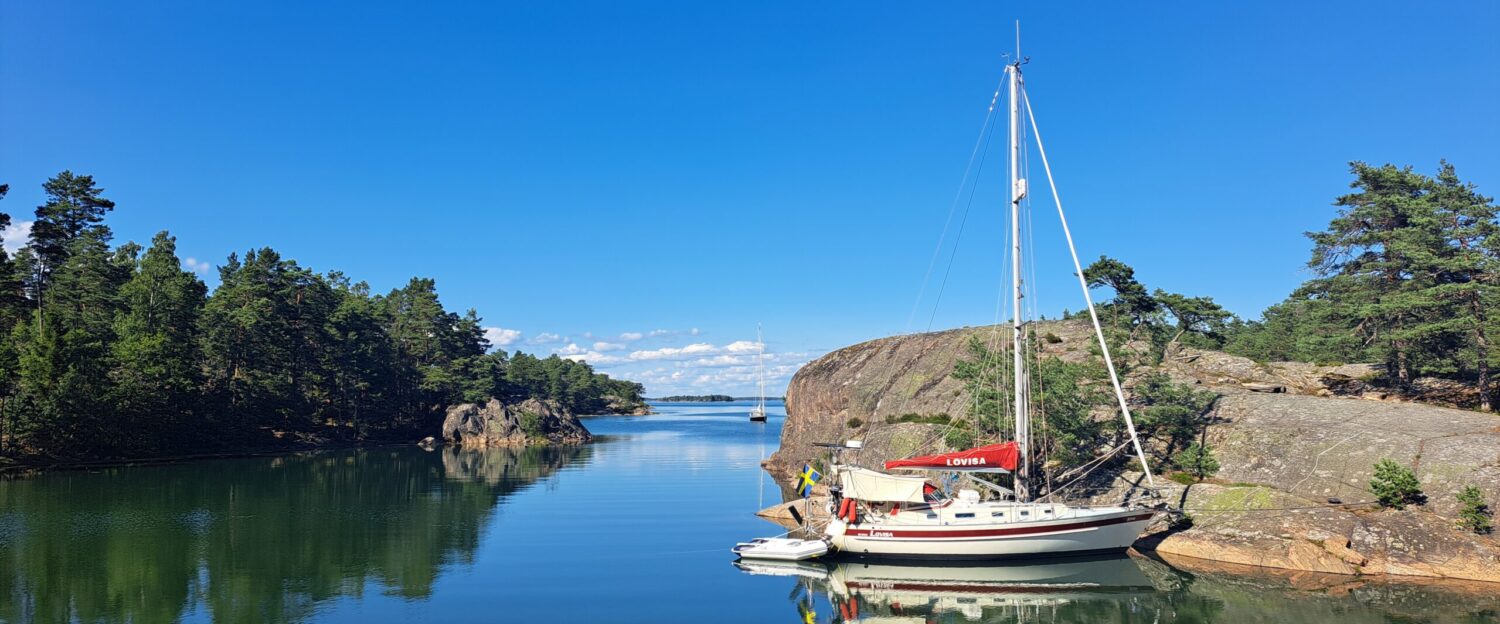
Ciao ragazzi!
Vi penso 💓
Grazie Titti!
Amazing ! Nice to hear all went well !
Greetings from NL
Philip
Thank you Philip ! Next will be the passage from Madeira to Canary Islands (don’t know yet which island). Should be around 2 days.
Emilien
Hi Emilien,
Exciting ! Looking forward to reading your next blog !
Safe travels !
Philip
Jag är imponerad av allt ni går igenom. orkar inte läsa precis allt men det verkar som att ni är med om mycket vackert och fint. Lycka till på färden. Kram